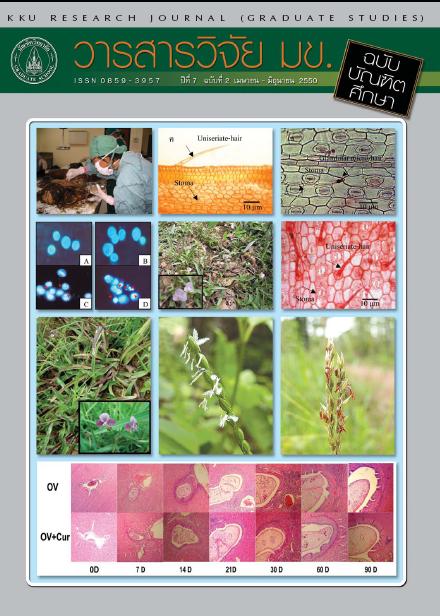Effect of Curcumin on the Expression of Inducible Nitric Oxide Synthase and Antioxidant Enzymns Genes in Hamsters Infected with Opisthorchis viverrini
Keywords:
Opisthorchis viverrini(พยาธิใบไม้ตับ), Curcumin(ขมิ้นชัน), Inducible nitric oxide synthase(อินดิวซิเบิลไนตริกออกไซด์ซินเตส), Antioxidant enzyme(แอนตี้ออกซิแดนซ์เอนไซม์)Abstract
โรคพยาธิใบไม้ตับที่เกิดจากการติดพยาธิ Opisthorchis viverrini เป็นปัจจัยเสี่ยงที่สำคัญในการเกิดโรคมะเร็งท่อน้ำดีความไม่สมดุลย์ระหว่างกระบวนการออกซิเดทีพและไนเตรทีพสเตรสและกระบวนการต่อต้านของเอนไซม์ต่อต้านอนุมูลอิสระในระหว่างการอักเสบแบบเรื้อรังทำให้เกิดพยาธิสภาพของโรคดังนั้นการใช้สารเคมีป้องกันโรคมายับยั้งกระบวนการอักเสบน่าจะช่วยลดความรุนแรงของโรคนี้ได้การศึกษาครั้งนี้จึงใช้ curcumin ซึ่งเป็นสารเคมีป้องกันโรคมาศึกษาดูผลต่อการแสดงออกของยีนอินดิวซิเบิลไนตริกออกไซด์ซินเตส (inducible nitric oxide synthase, iNOS) และยีนที่สร้างเอนไซม์ต่อต้านอนุมูลอิสระได้แก่ Cu/Zn superoxide dismutase (SOD1), Mn superoxide dismutase (SOD2), catalase (CAT) และ glutathione peroxidase (GPx) ในตับหนูที่ติดพยาธิใบไม้ตับโดยวิธี reverse transcription-polymerase chain reaction (RT-PCR) ผลการตรวจแบบกึ่งปริมาณ RT-PCR พบว่าการแสดงออกของยีนเหล่านี้จะเริ่มสูงขึ้นจากวันที่ 7 และเพิ่มสูงสุดในวันที่ 30 และมีแนวโน้มที่จะลดลงจนกระทั่งในวันที่ 90 ในหนูที่ติดพยาธิ O. viverrini ส่วนในหนูกลุ่มที่ได้รับ curcumin พบว่าระดับการแสดงออกของยีน SOD1, CAT และ GPx เพิ่มขึ้นแต่ระดับการแสดงออกของ iNOS และ SOD2 ลดลงเมื่อเปรียบเทียบกับกลุ่มที่ไม่ได้รับสาร curcumin สรุป curcumin อาจยับยั้งการแสดงออกของยีน iNOS และเหนี่ยวนำการแสดงออกของยีนที่ต่อต้านอนุมูลอิสระเพื่อยับยั้งไนเตรทีพสเตรสดังนั้น curcumin อาจนำมาใช้เป็นสารเคมีบำบัดเพื่อลดพยาธิสภาพของโรคพยาธิใบไม้ตับรวมทั้งป้องกันปัจจัยเสี่ยงของการเกิดโรคมะเร็งในท่อน้ำดี
Opisthorchiasis caused by infection with Opisthorchis viverrini is the major risk factor of cholangiocarcinoma (CCA). The imbalance of oxidative and nitrative stress and antioxidant enzyme defense mechanism during chronic inflammation leads to the pathophysiological disorder. Thus, using chemopreventive agent to inhibit inflammation might reduce the severity of the disease. In this experiment, curcumin (a chemopreventive agent) was used to study the effect on the expression of inducible nitric oxide synthase (iNOS) and antioxidant enzymes, such as Cu/Zn superoxide dismutase (SOD1), Mn SOD (SOD2), catalase (CAT) and glutathione peroxidase (GPx) in the O. viverrini-infected hamsters by using reverse transcription-polymerase chain reaction (RT-PCR) technique. Semiquantitative RT-PCR analysis showed that the profiles expression of iNOS, SOD1, SOD2, CAT and GPx mRNA in the liver of O. viverriniinfected hamsters gradually increased starting from day 7, reached the peak on day 30 and tended to decrease until day 90. The profiles of transcriptional expression levels of these genes were positively associated with the accumulation of inflammatory cells around the bile ducts. In curcumin-treated groups, these profile expression levels were similar to those in O. viverrini-infected groups but expression levels of these genes were different. Increased expression level of antioxidant enzymes (SOD1, CAT and GPx) but decreased expression level of iNOS and SOD2 was observed in curcumin-treated hamsters compared with non-treated group. Conclusively, curcumin might inhibit the expression of iNOS and induce antioxidant enzymes which, consequently, inhibit nitrative stress. Therefore, curcumin might be used as a chemopreventive agent to reduce the severity of opisthorchiasis as well as to prevent the risk of CCA development.



